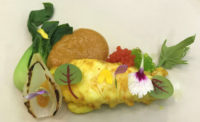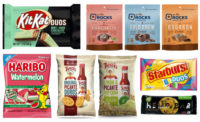Brandon Weimer and his best friend, Leah Post, just wanted to go to Italy.
In 2006, the then-high-school sophomores decided to fundraise for a class trip using a toffee recipe Weimer had learned from a family friend. Sales boomed, and they quickly eclipsed their fundraising goal, earning enough to cover their expenses.
Weimer and Post returned from their Italian adventure with a new mission. They founded Brandini Toffee, and since perfecting their recipe, they’ve gained distribution in mom-and-pop shops and opened standalone retail stores in Southern California.
Weimer said customers are surprised to find stores selling only toffee, but he said the capacity to support the standalone locations speaks to the rich, nostalgia-driven nature of the product.
“We focus on what we’re good at,” Weimer said. “We’re not here to reinvent the wheel with products we don’t know how to make.”
Toffee is as classic as it comes. Created by caramelizing sugar or molasses with butter and cooling it into breakable slabs, toffee has provided decades of decadence to candy lovers. Still, some consumers — especially young ones — may not understand toffee or know it at all, Weimer says.
“They think toffee is taffy or they think toffee is an inexpensive version they’ve tried in the past and that summarizes their whole perception on the category,” he says. “I think just like any boutique, quality item, it doesn’t always get the same attention as some mainstream (ones).”
That might explain sliding sales projections from Euromonitor International. The market research firm said the toffee, nougat and caramel category brought in $705.5 million in 2012. Revenue is expected to drop 9.5 percent to $638.8 million in 2017 and another 13 percent to $555.7 million in 2022.
Jim Simons, co-owner and v.p. of sales for Grand Junction, Colo.-based Enstrom Candies, agrees the category could benefit from more exposure.
“Toffee isn’t very prevalent in the industry,” he said. “You see more caramels and other chocolates more that you see toffee. Our goal is to help make toffee a more popular confection in stores across the country and around the world.”
One way to do that is by responding to overarching trends such as sugar reduction and portion control. Enstrom has introduced Almond Toffee Petites, 1-sq.-in. pieces of toffee and almonds enrobed in milk or dark chocolate and sprinkled with crushed almonds.
“Most of our new items in the national candy aisle are packed with small, individually-wrapped pieces so they can be enjoyed one bite at a time,” Simons says. “It’s too easy to open a large package of toffee and eat the entire thing!”
Finding new applications for the classic confection can also increase product and brand awareness. Betsy Thagard, founder of Newport, Calif.-based B. toffee, develops recipes using her pecan toffee, such as incorporating crushed toffee pieces into ice cream sandwiches and sprinkling frozen, chocolate-covered bananas with them.
Enstrom and Brandini Toffee also offer crushed toffee pieces for baking and topping ice cream, as well as popcorn and nut mixes coated with toffee.
Since toffee is largely associated with gifting and the holidays, it’s important to find avenues into the everyday category, Weimer says, especially considering his toffee requires refrigeration.
“As a competitive company, we’re looking for ways to hit that mainstream market, and I’d say toffee — at least in our current format for packaging and not being an enrobed product — is best refrigerated. It’s our biggest advantage and our biggest downfall.”
While it’s useful to experiment with different flavors and applications, there’s something to be said for holding onto the confection’s roots, Thagard says.
“There are so many trends to produce toffee with crazy flavors such as chili or strawberry, and while those are great, we feel like we are traditionalists,” she says. “Therefore, we offer our B. toffee in Milk and Dark chocolate flavors topped with roasted pecans...Sometimes less is more.”
Simons also pointed to the value in staying true to tradition, noting his grandfather, an ice cream maker, began producing it 1929.
”It has always been one of the highest quality confections, using only the finest ingredients available,” Simons says. “No matter how hard we try, Enstrom will always be synonymous with our decadent almond toffee.”
Regardless of the brand or the manufacturer — or whether it appears in large chunks or crushed on top of a bowl of ice cream — toffee’s richness will help it endure, Weimer says.
“There’s a lot of opportunity for gourmet toffee to expand and get more shine,” he says.








